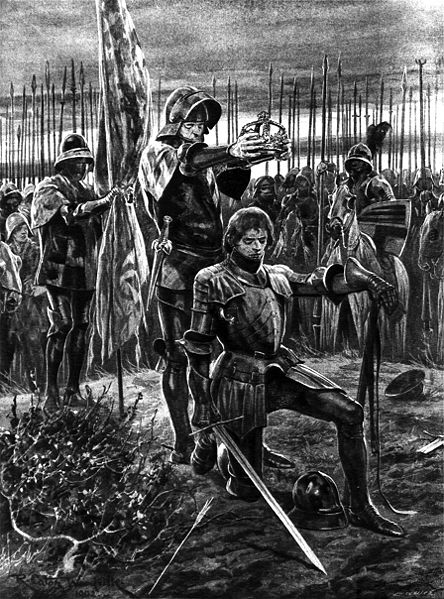The King's Body Guard of the Yeomen of the Guard is a bodyguard of the British monarch. The oldest British military corps still in existence, it was created by King Henry VII in 1485 after the Battle of Bosworth Field.
The Yeomen of the Guard on duty as the Queen's bodyguard at the State Opening of Parliament (2022).
1902 depiction of Henry Tudor on Crown Hill, surrounded by his Yeomen. Note the hawthorn bush in which Richard III's crown was reportedly found.
French Gardes Écossaises, from a 1610 drawing.
A long corridor in Hampton Court Palace. Here the Guard lined along the walls, forming a security cordon as the King passed.
The Battle of Bosworth or Bosworth Field was the last significant battle of the Wars of the Roses, the civil war between the houses of Lancaster and York that extended across England in the latter half of the 15th century. Fought on 22 August 1485, the battle was won by an alliance of Lancastrians and disaffected Yorkists. Their leader Henry Tudor, Earl of Richmond, became the first English monarch of the Tudor dynasty by his victory and subsequent marriage to a Yorkist princess. His opponent Richard III, the last king of the House of York, was killed during the battle, the last English monarch to die in combat. Historians consider Bosworth Field to mark the end of the Plantagenet dynasty, making it one of the defining moments of English history.
Battle of Bosworth, as depicted by Philip James de Loutherbourg (1740–1812); the painting dates to 1804 and the engraving dates to c. 1857
Elizabeth of York: rumours of her marriage launched Henry's invasion.
A stained-glass window in St James's Church, Sutton Cheney, commemorates the Battle of Bosworth fought nearby and the leaders of the combatants, Richard III (left) and Henry VII (right).
Finding Richard's circlet after the battle, Lord Stanley hands it to Henry.








